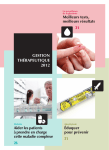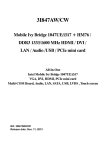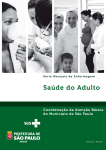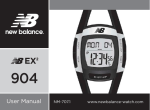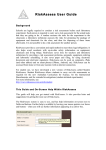Download CANRISK Canadian Diabetes Risk Questionnaire User Guide for
Transcript
CANRISK The Canadian Diabetes Risk Questionnaire User Guide for Pharmacists CANRISK The Canadian Diabetes Risk Questionnaire User Guide for Pharmacists What is CANRISK?1 CANRISK is a questionnaire that helps Canadians identify their risk of pre-diabetes or type 2 diabetes. It is mainly for adults between the ages of 45 and 74 years, but may also be used for younger groups in high-risk populations. Completing the questionnaire gives patients an overall CANRISK score that shows their risk of having pre-diabetes or diabetes. CANRISK was adapted from a similar questionnaire that is being used in Finland as part of its national diabetes prevention program (FINDRISC). The Public Health Agency of Canada (PHAC) convened a group of clinical and academic experts to modify the questionnaire so it would more accurately reflect known diabetes risk factors applicable to Canadians, such as the addition of new questions on ethnicity, education and gestational diabetes. In a recent Canadian peer-reviewed study involving over 6000 blood-tested adults, CANRISK scores were validated against diagnostic gold standard blood tests used in assessing diabetes risk in Canada’s multi-ethnic population.2 Why is the early detection of type 2 diabetes and pre‑diabetes important? Early detection decreases the risk of mortality and complications associated with diabetes If uncontrolled, diabetes can lead to macrovascular complications (heart disease, stroke) and microvascular complications (retinopathy, nephropathy and neuropathy). Consequently, people with diabetes tend to live an average of 5 to 10 years less than those without diabetes. Early detection of type 2 diabetes and pre-diabetes leads to earlier control of blood glucose which is crucial to preventing these complications. Early control of type 2 diabetes also reduces the risk of mortality as evidenced by the United Kingdom Prospective Diabetes Study (UKPDS).3 One-third of Canadians with diabetes are unaware of their condition Type 2 diabetes symptoms are often mild or asymptomatic, making detection of the disease challenging and leading to nearly 1 million Canadians being unaware that they are living with the disease.4 Additionally, there are 6 million Canadians living with pre-diabetes, meaning that their blood glucose is abnormally high but not high enough for a diabetes diagnosis.5 These individuals are up to 20 times more likely to develop type 2 diabetes! CANRISK can help raise the public’s awareness of their risk for diabetes so that action is taken to prevent or manage the disease. Early detection of diabetes decreases health care costs In 2010, the costs associated with managing diabetes were estimated at 12 billion dollars.6 This figure is expected to climb to 17 billion by the year 2020.6 Earlier detection of type 2 diabetes and pre-diabetes with CANRISK would help minimize these public health costs. 2 CANRISK • USER GUIDE FOR PHARMACISTS How does CANRISK Work?1 The CANRISK scoring system was developed based on a 4-year epidemiological study conducted by the Public Health Agency of Canada in collaboration with Health Regions in 7 participating provinces. This study used questionnaires to obtain data about diabetes risk factors and lifestyle behaviours among over 6200 adults, all of whom were then blood-tested using the Oral Glucose Tolerance Test to confirm their actual glycemic status. CANRISK scores were then developed from these data using Logistic regression in order to establish the strength of association (i.e., Odds Ratios) between various self-reported risk factors on the questionnaire and newly detected dysglycemia (diabetes or pre-diabetes) from the blood tests. CANRISK scores were based on follow-up blood testing using the standard 75 gram 2-hour Oral Glucose Tolerance Test (OGTT), which included the Fasting Plasma Glucose (FPG) test. If the FPG tests were used instead of OGTT for diagnosis, the likelihood of subsequent detection of dysglycemia would have been considerably reduced. In the CANRISK study, 59% of pre-diabetes and 52% of diabetes would have been missed using the FPG test alone. Implementing CANRISK in your pharmacy There are many ways to implement CANRISK as part of a daily routine in your pharmacy. Here are a few tips on how to introduce CANRISK to your patients: • Because it is such an easy tool to use, the pharmacist may choose to have students or pharmacy technicians administer the questionnaire to patients; however, the pharmacist must be available to address any questions or concerns that patients may have. • Pharmacists may incorporate CANRISK into their medication reviews. This can add value to the consultation and provide the pharmacist with an opportunity to discuss various lifestyle modifications in the interest of achieving better health outcomes for patients. • Pharmacists may ask willing patients to complete the CANRISK questionnaire while they wait for their prescriptions to be filled. This way, pharmacists can engage patients in constructive dialogue at the time their prescription is ready to be dispensed. Pharmacists could then document patients’ scores under their respective profiles. Interpreting CANRISK Scores1 CANRISK scores can be easily interpreted by summing up point scores for each of the 12 questions and then comparing the results with threshold scores for each of the 3 risk categories: • Low < 21 • Moderate 21–32 • High > 32 The score can also be converted to estimate the probability of current dysglycemia by using a formula described in Appendix A of the peer-reviewed article, Validating the CANRISK prognostic model for assessing diabetes risk in Canada’s multi-ethnic population (Chronic Diseases and Injuries in Canada, 2011).2 CANRISK • USER GUIDE FOR PHARMACISTS 3 A person’s risk of developing type 2 diabetes cannot be fully described by any single risk factor, so it is important to consider the overall CANRISK score rather than the point score for any single question. For instance, East Asian ethnicity has a relatively high point score for that question but the prevalence of obesity in East Asians is relatively low — so the overall risk level for the typical East Asian is likely low to moderate on average, reflecting the combined results of all risk factors. On an individual basis though, an obese East Asian would likely be at high risk of developing diabetes. Some lifestyle-related risk factors are modifiable, while others like age, ethnicity and family history of diabetes are not. It is important to be aware of the “nonmodifiable” factors since they contribute to an individual’s overall risk. Persons with similar BMI and waist circumference but with different ethnicity and family history would have considerably different risk scores. What is the Purpose of This Guide?1 This question-by-question guide provides you with an overview of the weighted score associated with each CANRISK question, the key messages to impart from each question as well as any tips or clarifications you may need when reviewing CANRISK with your patients. Your patient may ask you about the scoring points or why a certain question is being asked — for example, why does having an East Asian background give you 10 points, but “other” ethnicities only 3 points? The Key Message section below each question provides an overview of key points to discuss with your patients. Before You Begin1 Here are some key points to re-enforce with patients: • T here is no right or wrong answer. If the answers you provide are honest, the score will give you the best understanding of your risk for having diabetes. • T his is a self-reported questionnaire. What answer best describes you or your situation? • Answer all questions. Don’t leave check-boxes blank. • T he risk score is not intended as a substitute for an actual clinical diagnosis (which will require a blood test by a physician). • I f a patient has concerns about their risk score, encourage them to follow up with their family physician or nurse practitioner to discuss the results. 4 CANRISK • USER GUIDE FOR PHARMACISTS QUESTION 1 Age Select your age group: m 40–44 years 0 points m 55–64 years 13 points m 45–54 years 7 points m 65–74 years 15 points Tips • A lthough CANRISK scores for age begin at 45 years, there is no absolute threshold for diabetes risk based on age. • The relationship between age and diabetes risk is an upward-sloping curve. The CANRISK questionnaire is aimed mainly at middle-aged adults and seniors, though it may also be applied to younger persons from high-risk populations (i.e., non-white ethnicities). Key Message As with any chronic disease, as you get older, your risk of developing diabetes goes up. QUESTION 2 Gender Are you male or female? m Male 6 points m Female 0 points Key Message Males are at a higher risk for developing type 2 diabetes than females. This gender-based difference is due to a combination of physiological and behaviour-based differences between the sexes. CANRISK • USER GUIDE FOR PHARMACISTS 5 QUESTION 3 Weight, Height and Body Mass Index On the left-hand side of the BMI chart below, circle your height then look to the bottom of the chart and circle your weight. Find the square on the chart where your height crosses with your weight and note which shaded area you fall into. For example, if you are 5 feet, 2 inches (or 157.5 cm) and 163 pounds (or 74 kg) you fall in the LIGHT GREY area. Select your BMI group from the following choices: m White (BMI less than 25) 0 points m Light grey (BMI 25 to 29) 4 points m Dark grey (BMI 30 to 34) 9 points m Black (BMI 35 and over) 14 points Tips • I f your patient cannot find his/her exact weight on the BMI table, find approximately where it would be and draw a line from there. • I f it looks like your patient falls between an unshaded and a shaded area, round the BMI up to the higher area. • Your patient may need to use a ruler, straight edge or highlighter to draw lines on the table. Key Message Central or visceral obesity is strongly linked to insulin resistance and to an increased risk of type 2 diabetes. Decreasing body fat (especially visceral fat around the waist) has been shown to decrease the progression from pre-diabetes to type 2 diabetes. 6 CANRISK • USER GUIDE FOR PHARMACISTS QUESTION 4 Waist Circumference Using a tape measure, place it around your waist at the level of your belly button. MEN – Waist circumference: ______inches OR ______cm m Less than 94 cm or 37 inches 0 points m Between 94–102 cm or 37–40 inches 4 points m Over 102 cm or 40 inches 6 points WOMEN – Waist circumference: ______inches OR ______cm m Less than 80 cm or 31.5 inches 0 points m Between 80–88 cm or 31.5–35 inches 4 points m Over 88 cm or 35 inches 6 points Tips • Please advise your patients to measure their waist circumference while they are standing (this measurement is different from their pant size) and under their loose clothes (remove jacket or thick sweater) • If assisting with waist measurement, have the patient hold one end of the tape at their belly button, then turn in a circle to face you again. This will wrap the tape around the participant without you having to give them a ‘hug’. Key Message Body fat stored around the abdomen (rather than the hips and thighs) is a risk factor for developing type 2 diabetes. BMI assessments do not take into account where fat is stored. CANRISK • USER GUIDE FOR PHARMACISTS 7 QUESTION 5 Physical Activity Do you usually do some physical activity such as brisk walking for at least 30 minutes each day? This activity can be done while at work or at home. m Yes 0 points m No 1 point Tips • “Each day” means a daily average of 30 minutes per day or 150 minutes per week. • Although these options may seem limited, encourage your patient to try their best to answer as honestly as possible. Key Message Increasing physical activity is a key element in controlling weight and reducing the likelihood of developing type 2 diabetes. Every step counts and brisk walking is a great way to become more active. Aim for an average of 30 minutes per day or 150 minutes per week. Being active lowers blood glucose levels and may help your patient to: • reduce the amount of diabetes medication they need • improve their heart and lung function • reduce their risk of serious complications • control their weight and relieve tension or stress 8 CANRISK • USER GUIDE FOR PHARMACISTS QUESTION 6 Fruits and Vegetables How often do you eat vegetables or fruits? m Every day 0 points m Not every day 2 points Tips • A lthough the response options may seem limited, encourage your patient to try their best to answer as honestly as possible. Key Message By eating foods that are rich in fibre, reducing the amount of fat in food selections and adding more fruits and vegetables, your patient can help control their diet and maintain or lose weight. Patients should also try to reduce the amount of salt in their diet in order to lower their blood pressure and reduce their elevated risk of stroke. QUESTION 7 Blood Pressure Have you ever been told by a doctor or nurse that you have high blood pressure OR have you ever taken high blood pressure pills? m Yes 4 points m No or don’t know 0 points Tips • Y our patient should check “yes” if they were ever told by a health professional that their blood pressure was high, even once. Key Message Diabetes and high blood pressure are often clustered together. Many people with undiagnosed type 2 diabetes have high blood pressure. Good control of blood pressure can substantially reduce your risk of developing cardiovascular complications such as heart attack and stroke. You can help lower your blood pressure by reducing the amount of salt in your diet — by choosing to eat fewer processed foods and foods high in salt such as processed meat, cheese and salty snacks. CANRISK • USER GUIDE FOR PHARMACISTS 9 QUESTION 8 High Blood Sugar Have you ever been found to have a high blood sugar either from a blood test, during an illness, or during pregnancy? m Yes 14 points m No or don’t know 0 points Tips • This question measures if patients were ever told their blood glucose was high or abnormal (even once, regardless of whether they have been given medications). • If your patient had their blood glucose tested but did not have an abnormal result, then they should answer “no”. • This question presumes that the person being assessed has never been diagnosed with diabetes but may have had gestational diabetes or a one-time abnormal result during an illness, etc. • Your patient should answer “yes” if they have ever had one or more high blood glucose readings, even if they have never been diagnosed with diabetes. Key Message Previous test results indicating abnormally high blood sugar are an indication of temporary metabolic problems or possible diabetes. They are a warning sign that your patient may be at risk for developing full-blown diabetes in the future. QUESTION 9 High Birth Weight Babies Have you ever given birth to a large baby weighing 9 lbs (4.1 kg) or more? m Yes 1 point m No, don’t know or not applicable 0 points Tips • This macrosomia question is also intended as a cue to confirm the answer to question 8 for women who declare having had gestational diabetes but no history of high blood sugar. Key Message Giving birth to a large infant over 4.1 kg (macrosomia) is related to high maternal weight gain during pregnancy, which is associated with gestational diabetes. Gestational diabetes is a risk factor for developing type 2 diabetes later on, postpartum. 10 CANRISK • USER GUIDE FOR PHARMACISTS QUESTION 10 Family History of Diabetes Have any of your blood relatives ever been diagnosed with diabetes? Check ALL that apply. m Mother 2 points m Father 2 points m Brothers/Sisters 2 points m Children 2 points m Other 0 points m No/don’t know 0 points Tips • If your patient does not have any family history of diabetes, remind them to check off “No” (don’t leave checkboxes blank). This response includes: • Any form of diagnosed diabetes that is treated with diet and exercise, pills or insulin. • Type 1 diabetes This response does not include: • Gestational diabetes • Pre-diabetes (i.e., reported “borderline diabetes” or any other condition that has not been diagnosed by a physician as diabetes) • A spouse, step-children or relatives who are not related by blood. Key Message Diabetes can run in families. Diabetes risk is strongly related to family history among close relatives (mother, father, sister, brother, child). This reflects the combined effect of shared genetic material as well as shared lifestyles and cultural behaviours (e.g., eating the same food at the dinner table). CANRISK • USER GUIDE FOR PHARMACISTS 11 QUESTION 11 Mother’s and Father’s Ethnicity Please check off which of the following ethnic groups your biological (blood) parents belong to: Mother Father m m White (Caucasian) 0 points m m Aboriginal (First Nations Person, Métis, Inuit) 3 points m m Black (Afro-Caribbean) 5 points m m East Asian (Chinese, Vietnamese, Filipino, Korean, etc.) 10 points m m South Asian (East Indian, Pakistani, Sri Lankan, etc.) 11 points m m Other non-white (Latin American, Arab, West Asian) 3 points Tips • If your patient’s parents have different ethnicities, choose the one with the higher score (but do not add them). The maximum score for this question is 11. • If your patient’s mother or father is of European ethnicity, check off “White (Caucasian)”. • NOTE: some persons living in “Latin America” may choose to self-identify as “White (Caucasian)” if they believe their parents were Spanish-Caucasian rather than Mestizo (mixed European and Native American heritage). • If your patient’s mother or father is of mixed ethnicity, check off “Other”. Key Message Certain ethno-cultural groups are at higher risk of developing diabetes. The risk due to ethnicity cannot be interpreted by itself without considering the added effect of other factors towards the overall CANRISK score. 12 CANRISK • USER GUIDE FOR PHARMACISTS QUESTION 12 Education What is the highest level of education that you have completed? m Some high school or less 5 points m High school diploma 1 point m Some college or university 0 points m University or college degree 0 points Key Message An individual’s health status improves with education. Education improves people’s ability to access and understand information to help keep them healthy. Education is closely tied to socioeconomic status, and effective education for children and lifelong learning for adults are key contributors to health. CANRISK • USER GUIDE FOR PHARMACISTS 13 After the patient has completed CANRISK7 If the patient is completing the CANRISK questionnaire online, encourage them to print the results in order to facilitate discussion about their diabetes risk with you. The patient may also click on the tab titled “More Information” to receive additional information about diabetes. Table 1 outlines communication points and messaging that can be delivered to patients according to their overall CANRISK score. The pharmacist should then make recommendations based on a patient’s individual risk factors (i.e., according to their answers of individual questions on the CANRISK questionnaire) using Table 2. Appendix 1 contains a guideline developed by the Canadian Task Force on Preventive Health Care (CTFPHC) and published in the Canadian Medical Association Journal (CMAJ) that identifies further rationale for diabetes screening. Table 1: Patient Messaging Tips According to CANRISK Score7 Diabetes Risk (CANRISK Score) Patient Messaging Tips Low (Green) (< 21 points) • “Congratulations, based on the risk factors identified in the CANRISK questionnaire, your risk of having pre-diabetes or diabetes is low.” • “The risk for type 2 diabetes increases as we get older. You should have your blood sugar tested: • once a year (for individuals with one or more risk factors other than age) • every 3 years or as recommended by your doctor (for individuals with no risk factors other than age)” • Engage patient in lifestyle modification discussion based on individual need (see Table 2). Moderate (Yellow) (21–32 points) • “Based on the risk factors identified in the CANRISK questionnaire, your risk of having pre-diabetes or diabetes is moderate. You may want to show your family doctor your questionnaire results and discuss your risk of developing diabetes.” • “You should have your blood sugar tested, unless it has already been tested by a physician within the past 3 years.” • “While you can’t change some risk factors (age, family history, ethnic background), other risk factors for diabetes may respond to lifestyle changes.” • Engage patient in lifestyle modification discussion based on individual need (see Table 2). High (Red) (> 33 points) • “Based on the risk factors identified in the CANRISK questionnaire, your risk of having pre-diabetes or diabetes is high. You may want to show your family doctor your questionnaire results and talk about getting your blood sugar tested.” • “Although your risk for diabetes is high, studies have shown that you can prevent or delay the onset of diabetes by increasing your level of physical activity, improving your diet and losing some weight.” • “May I have your permission to fax this information to your doctor so that he/she can review your CANRISK results and further assess your diabetes risk?” • Engage patient in lifestyle modification discussion based on individual need (see Table 2). Table 2 describes lifestyle modifications that have shown to decrease the risk of developing diabetes in those who have pre-diabetes. It also provides support materials for health professionals and patients that focus on these specific lifestyle modifications. 14 CANRISK • USER GUIDE FOR PHARMACISTS Table 2: Lifestyle Modification Recommendations for Prevention and Management of Type 2 Diabetes7 Physical Activity Patient Messages •Try to engage in moderate physical activity (activity that makes you breathe faster and your heart beat faster than normal) such as walking at a brisk pace, skating or bicycle riding for at least 150 minutes per week. Activity can be broken up into segments of 10 minutes at a time. •It’s easier to keep active if you choose an activity you enjoy and get someone to join you, or get involved in team sports. Make it social! •If you have a medical condition, talk to your doctor about the level of physical activity that is right for you. Do not increase your level of physical activity until you have discussed these plans with your doctor. Additional Education Support for Health Professionals •Diabetes Strategy for Pharmacists: www.diabetespharmacists.ca Support Materials for Patients Give to patient the following publications as appropriate: •Physical activity and exercise — for consumers: www.diabetes.ca/diabetes-andyou/healthy-guidelines/physical-activity-and-exercise/ •Physical activity and diabetes: www.diabetes.ca/files/PhysicalActivity.pdf Nutrition Patient Messages •Use Canada’s Food Guide to help you meet your needs for vitamins, minerals and other nutrients. •Eat at least 1 dark green and 1 orange vegetable each day. •Satisfy your thirst with water. •Choose foods that are lower in fat, sugar and salt. •Have vegetables and fruit more often than juice. •Make at least half of your grain products whole grain each day. •Drink skim, 1% or 2% milk each day. •Have meat alternatives such as beans, lentils and tofu often. •Eat at least 2 Canada Food Guide servings of fish each week. •Include a small amount of unsaturated fat each day. •Reduce the amount of salt (sodium) in your diet by choosing low-sodium foods and by eating less fast food and other processed food. •Use 1/2 your dinner plate for vegetables, 1/4 for grains and starches and 1/4 for meat and alternatives. Additional Education Support for Health Professionals •Diabetes Strategy for Pharmacists: www.diabetespharmacists.ca •Canada’s Food Guide (Health Canada): www.hc-sc.gc.ca/fn-an/food-guide-aliment/index-eng.php Support Materials for Patients Give to patient the following publications as appropriate: •Just the basics: Tips for healthy eating, diabetes prevention and management: www.diabetes.ca/files/JTB17x_11_CPGO3_1103.pdf •Any of the handouts as deemed appropriate as found on the CDA webpage titled “Diabetes and you: Nutrition”: www.diabetes.ca/diabetes-and-you/nutrition/just-basics/ Continued on page 16 CANRISK • USER GUIDE FOR PHARMACISTS 15 Table 2: Lifestyle Modification Recommendations for Prevention and Management of Type 2 Diabetes7 ...continued Weight Management Patient Messages •If you are considerably overweight, achieving a normal BMI may seem overwhelming. However, it is important to realize that weight loss is not an all or nothing proposition. Losing even 5%–10% of your weight can be very beneficial to your health and will significantly reduce your risk of developing type 2 diabetes. •An approach to diet change resulting in weight loss that can be maintained over time is a necessity. This is where “fad diets” usually fail. •The 2006 Canadian clinical practice guidelines on the management and prevention of obesity in adults and children recommend weight loss of 0.5–1 kg (1–2 pounds) per week. •One pound of fat contains 3500 calories. Reducing your dietary intake by just 500 calories per day can result in weight loss of 1 pound per week. Calories expended through physical activity will help with weight loss and weight maintenance. Additional Education Support for Health Professionals •Diabetes Strategy for Pharmacists: www.diabetespharmacists.ca Support Materials for Patients Give to patient the following publication as appropriate: •Managing weight: www.diabetes.ca/documents/about-diabetes/17215-Managing_Weight.pdf Acknowledgements The original CANRISK User Guide for Pharmacists was developed by the Public Health Agency of Canada (PHAC). This expanded version was brought together by the Canadian Pharmacists Association (CPhA) with support from PHAC and educational materials from Shoppers Drug Mart. References 1. Public Health Agency of Canada. CANRISK: the Canadian diabetes risk questionnaire user guide for pharmacists. Ottawa (ON): Public Health Agency of Canada; 2011. 2. Robinson CA, Agarwal G, Nerenberg K. Validating the CANRISK prognostic model for assessing diabetes risk in Canada’s multi-ethnic population. Chronic Dis Inj Can 2011;32(1):19-31. 3. American Diabetes Association. Implications of the United Kingdom Prospective Diabetes Study. Diabetes Care 2002;25(suppl 1):S28-S32. 4. Eye Health Council of Ontario. Guidelines for the collaborative management of persons with diabetes mellitus by eye care professionals. CJO 2011;73(4):26-35. 5. Canadian Diabetes Association. Diabetes in Canada: it’s time for action. Available: www.diabetes.ca/about-us/media-releases-entry/diabetes-in-canada-its-time-for-action/ (accessed October 7, 2012). 6. Canadian Diabetes Association. An economic tsunami: the cost of diabetes in Canada. Toronto (ON): Canadian Diabetes Association; 2009. Available: www.diabetes.ca/documents/get-involved/FINAL_Economic_Report.pdf (accessed October 7, 2012). 7. Shoppers Drug Mart. Implementation of the CANRISK questionnaire in the pharmacy: the role of interactive pharmacistpatient communication. Toronto (ON): Shoppers Drug Mart; 2012. 16 CANRISK • USER GUIDE FOR PHARMACISTS
















